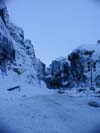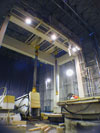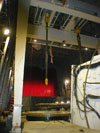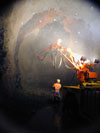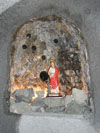Impregilo completes +60km of tunnelling for Iceland’s Kárahnjúkar power station
Apr 2008
Shani Wallis, Editor
- In early April, members of the Impregilo team and others gathered to celebrate the last breakthrough of more than 60km of tunnelling for the Kárahnjúkar hydropower project in Iceland’s harsh eastern wilderness.
-

Final breakthrough
- Although overshadowed by earlier breakthroughs, the event ended four grueling years of effort for Impregilo and its tunnelling teams, battling not only the elements of this region’s fierce climate, but also at times, overwhelming geological conditions.
- “Since mobilizing our two contracts in late-2003, we have faced some of the most extreme working conditions in the company’s tunnelling history,” explained Gianni Porta, Project Manager for Impregilo and leader of the team since the start. “This has been an endurance test for everyone associated with the project and we can take great satisfaction in achieving what we have.”
-

Fig 1. Plan
- The final breakthrough on April 9, 2008, completes 8.5km of the Jökulsá Diversion Tunnel and brings to an end more than 48km of TBM tunnelling and a further 12.6km of drill+blast tunnels on Impregilo’s two contracts (Tables 1 and 2). Prior to this last breakthrough, Impregilo had completed the 198m high concrete-faced, rock-filled dam and the 39.6km, 7.2-7.6m diameter main headrace tunnel to bring the six 115KW Francis turbines in the project’s underground powerhouse on-line in November 2007 (Fig 1).
- To complete the total 48km of TBM tunnelling, Impregilo selected three new 7.2-7.6m diameter Robbins main beam gripper TBMs fitted for the first time with 19in backloading Robbins cutters and continuous conveyor mucking systems supplied by Continental Conveyors. With conveyors traveling at 2.5m/sec and calibrated to carry some 800-tonne/h, the TBM programme was based on sustaining an average rate of 25m/day working three 8h shifts/day, six-days/week and with a full maintenance shift/week for each TBM and its conveyor system.
- While there were many interruptions to deal with tough geological conditions, the best rates recorded are 115m in one day and 429m in a six-day week – both achieved on the last drive and claimed as records for TBMs of this diameter in hard rock – and 1,194m in a single production month.
| Total Length(m) | TBM(m) | D+B(m) | |
| Headrace (HRT) + Jökulsá Diversion | |||
| Adit 1 | 1,260 | 0 | 1,260 |
| Adit 2 | 3,109 | 1,458 | 1,651 |
| Adit 3 | 2,996 | 2,625 | 371 |
| Surge Tunnel | 1,679 | 0 | 1,679 |
| Drainage Tunnel | 736 | 0 | 736 |
| HRT1 from Adit1 | 15,132 | 14,657 | 475 |
| HRT2 from Adit2 | 10,275 | 8,872 | 1,403 |
| HRT3 from Adit3 | 12,659 | 11,931 | 728 |
| HRT from Adit 4 | 550 | 0 | 550 |
| HRT3 from Reservoir Intake | 1,011 | 0 | 1,011 |
| Jökulsa Diversion from Adit 2 | 8,970 | 8,503 | 467 |
| Totals | 58,377 | 48,046 | 10,331 |
| Dam site tunnels | |||
| Inspection/Grouting Gallery L&R | 490 | 490 | |
| Access 2 Gallery | 190 | 190 | |
| Diversion Tunnel T1 | 763 | 763 | |
| Diversion Tunnel T2 | 844 | 844 | |
| Sub-Total | 2,287 | 2,287 | |
| Grand Totals | 60,664 | 48,046 | 12,618 |
- Open, main-beam TBM tunnelling was recommended for the long drives to power through shallow dipping lava flows of strong (100-250MPa UCS) but not overly abrasive basalt. Between eruptions and bedded between lava flows are bands of sediments deposited in thin to quite thick layers of 2-80MPa in UCS. Cover over the tunnels is generally 100-200m but as low as 55m beneath several small rivers. Steel-fibre reinforced shotcrete and rockbolts provide support and lining where necessary in tunnels that are designed to remain largely unlined.
-

Extreme water inflow conditions
- On Impregilo’s long TBM drives, TBM2 had the hardest struggle. At 5km into its 10.4km long drive from Adit 2, the TBM encountered a series of faults up to 8m wide and comprising heavily sheared, loose basalt rocks. It took six months to inch through this 55m zone using a combination of grouting, spilling, close-spaced steel sets and poured concrete infill to make headway.
- Although it recorded the best monthly advance rate, TBM3 hit the greatest water ingress problems. Systematic probing was a contract requirement in anticipation of high ground water inflows on all the tunnel headings and pay schedules for managing water flows were established on bands of 50l/sec from a base of 100l/sec to an initial maximum estimate of 550l/sec. Actual inflows in the TBM3 uphill drive peaked at near 1,000l/sec with pressures of up to 8 bar recorded. When progress was demanding several days and excessive volumes of grouting to stem flows, Impregilo decided to suspend the TBM drive and complete the remaining 1.12km of the heading with drill+blast, excavating a fourth adit to provide quicker access for men, materials and mucking trucks.
Project players
Owner
Iceland’s publicly-owned power company Landsvirkjun
Designers
VST, Rafteikning, Almenna Verkfraedistofan of Iceland with Electrowatt of Switzerland for the tunnels, and Harza of the United States (now part of HMW) for the dam.
Construction supervision
Contract KAR-11 (Dam) and KAR-14 (Tunnels): Mott MacDonald of the UK with Coyne et Bellier (France), Norconsult (Norway), Swedco (Sweden), and Línuhönnun, Hnit and Fjarhitun of Iceland.
Contract KAR-15 (Powerstation): Lahmeyer of Germany with Hönnun, Almenna Verkfraedistofan, VSÓ Rádgjöf and Rafhonnun of Iceland
Contract KAR-15 (Powerstation): Lahmeyer of Germany with Hönnun, Almenna Verkfraedistofan, VSÓ Rádgjöf and Rafhonnun of Iceland
Construction Contracts
KAR-15 Powerstation: Fosskraft JV, led by Hochtief of Germany
KAR-11 (Dam) and KAR-14 (Tunnels): Impregilo of Italy
KAR-11 (Dam) and KAR-14 (Tunnels): Impregilo of Italy
- TBM3 and its conveyor system were dismantled and backed out completely to the surface at Adit 3 before being reassembled and relaunched on the downhill drive to meet TBM2 advancing uphill from Adit 2. The TBM turn around took nearly six months.
- With cumulative inflows along the headrace reaching some 1,300l/sec, the water was put to good use. “Starting from mid-July 2007, with the TBM1 headrace drive complete and while we completed the final supports and invert lining in the upper headrace TBM2 and TBM3 drives, we allowed that lower part of the headrace to fill with inflow and this was sufficient for testing the installed turbines,” explained Porta. “We completed the upper TBM and drill+blast drives in mid-October and, having already partially wet-tested the turbines, the Client was able to put five turbines into operation in the period from 3rd to 23rd November 2007. This is something of a record in itself.”
-
Underground shelter
The full 39.6km of the main headrace took a total 28 construction months from September 2004 to December 2006 to complete. It was TBM2 that was relaunched at Adit 2 in April 2007 to complete its 8.5km of the total 13.3km long Jökulsá tunnel toward its breakthrough in April 2008 with a drill+blast heading completed by a local contract from the opposite portal. - As tough as conditions were inside the tunnels, that was frequently the better place to be. Working conditions on the surface were often brutal. Winter temperatures regularly reached -25ºC with short days, long nights, blinding snow blizzards, wind speeds up to 176km/hr and a wind chill factor adding to the extreme. This affected every aspect of the construction effort, from finding supply deliveries beneath high snow drifts, to batching concrete, assembling TBMs, and keeping the workforce committed to staying the course.
-

Camp at dam
- Recruiting its full contingent of some 1,300 workers from within Iceland was not possible and Impregilo employed workers trained on its previous tunnel and dam contracts in China, Columbia, Portugal and other distant places. At peak there were some 42 different nationalities represented and all were housed in camps of dorms, canteens, homes and offices established by Impregilo – the largest at the dam site and with satellites at each of the TBM adit portals. The international teams were well used to life in camps on large remote construction projects but winter conditions were experiences not previously imagined.
-

TBM backup assembly
As programming would have it, much of the equipment needed on the contracts was erected in the winter months. The first Robbins TBM arrived in December 2003 and was assembled in a temporary purpose-built weatherproof workshop that provided a reasonable working environment and safeguarded the temperature sensitive components. As assembly of the TBM progressed, there was sympathy for those working outside erecting the back-up trailers and the headframe for the continuous conveyor. The TBM assembly building was dismantled and moved to Adits 2 and 1 consecutively for assembly of the next two machines when they arrived in March and April 2004 respectively.
- Batching concrete and shotcrete required particular attention. Aggregate had to be stored in steam-heated containers; hot water at 80°C was used in the mixes; and mixer trucks had to be de-iced before being filled in efforts to maintain correct temperatures for effective curing.
-

Dam batch plant
- Impregilo produced and placed more than 225,000m3 of poured concrete and more than 80,000m3 of wet-mix, 40kg/m3 steel-fibre reinforced shotcrete for both contracts. At the power station Fosskraft placed 50-55,000m3 of concrete, more than 10,000m3 as primary support shotcrete.
- For all concrete additive and shotcreting needs, the contractors selected Sika/Putzmeister equipment and materials. Sika Viscocrete 3060 IS superplacticer and Sika AER air entrainer sustained the working life of the concrete during transportation and Sika’s alkali-free Sigunit AF 53 was the accelerator of choice for all shotcrete operations.
- Other factors influence the final decision between surface or subsurface alignment, including important environmental concerns and land acquisition costs, but a suggested way around the dilemma, said Herdina, might be to build the new underground lines strictly for freight trains and reserve the existing largely surface alignments for passenger services. The long underground freight-only tunnels would not require the same degree of public fire-life-safety facilities and the cost effective advantages of building large double-track tunnels could be retained.
- For its contracts Impregilo took delivery of eight shotcreting units. Four new Sika-PM 500P mobile wet-mix shotcrete robots equipped with Putzmeister BSA 1005 pumps and a small Aliva-504 portable unit for working in the grouting galleries for the dam. On the TBMs, the shotcrete stations were located about 30m behind the cutterhead and comprised an Aliva-263 wet or dry-mix Duplo machine and a ring beam-mounted nozzle. Putzmeister also supplied truck-mounted M36 boom pumps to Impregilo for in-situ concrete structures.
- Breakthrough of the last TBM drive in early April was a momentous milestone for Impregilo and for the project. “With this final celebration and after completing the last finishing and demobilization works, we expect to be leaving the site by October 2008,” said Porta, “and with all issues resolved and settled with the Client.
-

Shotcreting
- The tremendous effort that has been construction of the $US1.3 billion Kárahnjúkar project has earned it a place in the tunnelling and dam construction Hall of Fame. Lok Home, President of The Robbins Company, who traveled to Iceland for the final breakthrough, reflected: “You have a few great projects in your career and this was one of them. Not because everything went as planned, but because it presented challenges - from specifying the TBMs to completing the final meters of the tunnel. We worked in close cooperation with the Contractor to overcome the challenges and to register what could be done better next time. It was a satisfying project.”
- With the fate of the last TBM yet to be decided, the other two are already reassigned and working their new jobs. After a Robbins refurbishment and change of diameter to 9.8m, TBM1 is in Switzerland and was recently launched on the 2.4km long access adit contract for the Monte Ceneri base tunnel on Switzerland’s St Gotthard axis AlpTransit railway project. TBM2 is supplied by Robbins to China to work, at the same diameter, on the Jinping 1 water project.
- In Iceland, the 4,600GWh of electricity generated annually by the Kárahnjúkar power plant will be consumed by a single customer. The project is built by Iceland specifically to take advantage of the abundant, reliable and fixed-price source of electricity and support a new aluminium smelting plant established by Alcoa about 100km from the dam on the northeast coast of Iceland. Despite the tunnelling delays, Landsvirkjun was able to meet its electricity delivery commitments to Alcoa from the national grid and until acceleration measures and innovative means of testing the turbines were worked out with Impregilo to bring the power station on-line sooner than would otherwise have been the case.
- The economic benefit to Alcoa, and to Iceland, in its need to diversify away from a shrinking finishing industry, is thanks in huge measure to Impregilo’s tunnellers, workers, management, and all who persevered and prevailed at Kárahnjúkar.
-
Associated links
www.karahnjukar.is
www.impregilo.it
www.robbinstbm.com
www.continentalconveyor.com
www.sika.com
www.putzmeister.com





